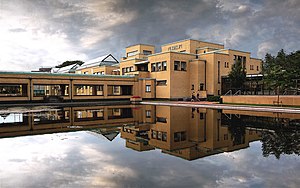H. P. Berlage
Hendrik Petrus Berlage | |
|---|---|
 | |
| Born | February 21, 1856 Amsterdam, Netherlands |
| Died | August 12, 1934 (aged 78) |
| Nationality | Dutch |
| Alma mater | ETH Zurich |
| Occupation | Architect |
| Buildings |
|
| Projects |
|



Hendrik Petrus Berlage (21 February 1856 – 12 August 1934) was a prominent Dutch architect.
Overview
Berlage was born in Amsterdam. He studied architecture at the Zurich Institute of Technology between 1875 and 1878 after which he traveled extensively for 3 years through Europe. In the 1880s he formed a Partnership in the Netherlands with Theodore Sanders which produced a mixture of practical and utopian projects. A published author, Berlage held memberships in various architectural societies including CIAM I.
Berlage was influenced by the Neo-Romanesque brickwork architecture of Henry Hobson Richardson and of the combination of structures of iron seen with brick of the Castle of the Three Geckos of Domènech i Montaner. This influence is visible in his design for the Amsterdam Commodities Exchange, for which he would also draw on the ideas of Viollet-le-Duc. The load-bearing bare brick walls and the notion of the primacy of space, and of walls as the creators of form, would be the constitutive principles of the 'Hollandse Zakelijkheid'. A visit Berlage made to the U.S. in 1911 greatly affected his architecture. From then on the organic architecture of Frank Lloyd Wright would be a significant influence. Lectures he gave when returned to Europe would help to disseminate Wright's thoughts in Germany.
Considered the "Father of Modern architecture" in the Netherlands and the intermediary between the Traditionalists and the Modernists, Berlage's theories inspired most Dutch architectural groups of the 1920s, including the Traditionalists, the Amsterdam School, De Stijl and the New Objectivists. He received the British RIBA Royal Gold Medal in 1932.
Berlage died at The Hague in 1934. In 1970, the IAU named the lunar crater Berlage after him.[1]
Public collections
Among the public collections holding works by Hendrik Petrus Berlage are:
See also
References
- ^ Descriptive data on lunar craters from the United States Geological Survey. (Click on the crater name ) : "Gazetteer of Planetary Nomenclature - Moon Nomenclature: Crater, craters". from http://planetarynames.wr.usgs.gov/ Astrogeology Research Program, U.S. Geological Survey. Retrieved 2007-08-05.
{{cite web}}: External link in|work=
Further reading
- Sergio Polano, Giovanni Fanelli, Vincent Van Rossem (2002) : Hendrik Petrus Berlage, Phaidon Press, ISBN 1-904313-11-6
- Hendrik Berlage (1996): Hendrik Petrus Berlage: Thoughts on Style, 1886-1909 (Texts & Documents), The Getty Center For The History Of Art, ISBN 0-89236-334-7
- KOHLENBACH (1991): H.P. Berlage: SCHRIFTEN ZUR ARCHITEKtur, Birkhäuser Basel; ISBN 3-7643-2587-9 (German edition)
- Singelenberg, Pieter (1972): H.P. Berlage. Idea and style. The quest for modern architecture, Utrecht, Haentjens Dekker & Gumbert
- Dennis Sharp (1991): Illustrated Encyclopedia of Architects and Architecture, Watson-Guptill, ISBN 0-8230-2539-X, ISBN 978-0-8230-2539-8
